Direct connection with Shanghai opens new commercial horizons, but shortcomings are limiting the port’s operational reach
Land connectivity issues are hampering operations at the new Peruvian mega-port of Chancay, according to a report in La República.

Since its official inauguration last November, the port has handled nearly 60,000 containers and seeks to consolidate itself as a new trade hub between South America and Asia. It now operates four shipping services, including a direct route to Shanghai, reducing handling times to 23 days.
Among the main challenges cited is the limited land connectivity with Lima and Callao. “Of the four road projects prioritised by the National Infrastructure Authority to connect Chancay with the northern part of the capital, only one has shown concrete progress,” the report notes.
“Added to this are delays in key projects such as the Chancayllo–Chancay highway and the Serpentín dual carriageway. This situation affects the efficiency of cargo transportation to and from the port.”
Furthermore, the area surrounding Chancay lacks an approved Urban Development Plan. Although a technical proposal exists, the document remains under review due to conflicts between different levels of government. “This prevents the development of more than 7,000ha with industrial potential and limits the attraction of new private investment,” La República noted.
The National Autonomous Authority for the Strategic Development of the Chancay Port Terminal was created to handle these challenges. However, the newspaper notes that to date, its role has focused on “the execution of specific projects without addressing the structural governance and institutional problems highlighted by various specialists”.
Meanwhile, growing geopolitical unrest is adding another layer of complexity to the port’s operations. Trade tensions between the US and China have rekindled the debate about Peru’s role in the international trade dynamic, in particular how Washington US will perceive Chancay’s growing role as a key platform for Chinese interests in Latin America.
“Although a scenario of direct intervention has been ruled out, questions remain about the balance Peru must maintain between its trade ties with Asia and its long-standing relationship with the US,” the report notes.
Currently, 20 per cent of Peru’s foreign trade is directed to the Asian market, while the US remains a major partner, especially for agricultural exports.



